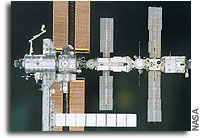Space Station Crew Begins November With Science Experiments

Expedition 10’s second full week as the International Space Station’s resident crew was filled with science experiments, routine maintenance work and ISS familiarization activities. Expedition 10 Commander Leroy Chiao and Flight Engineer Salizhan Sharipov took over Station operations on Oct. 23 when Expedition 9 departed.
One of the experiments they conducted was the Diagnostic Ultrasound in Microgravity (ADUM) medical experiment. ADUM seeks to better understand the ability of crewmembers to do ultrasound scans and transmit the data to the ground. The application may also find benefits on Earth, allowing for much quicker injury diagnosis for patients at remote locations by doctors based at hospitals.
Chiao also worked with the Binary Colloid Alloy Test 3 which is studying the long-term behavior of colloids — fine particles suspended in a fluid — in a microgravity environment, where the effects of sedimentation and convection are removed. Crewmembers will even out the samples, photograph the growth and formations of the colloids, and downlink the images for analysis.
On Thursday, Chiao and Sharipov took part in an emergency medical training drill. The one-hour mandatory session is designed to give the crew refresher training on medical equipment aboard the Space Station. They also continued to familiarize themselves with the ISS during hourly sessions each day.
Maintenance activities included the replacement of smoke detectors in the Zarya Control Module.
Tuesday marked the fourth anniversary of the Expedition 1 crew’s arrival at the International Space Station. Since then, nine more crews have maintained a continuous human habitation of the orbital outpost.
On the ground, Expedition 9 crewmembers Gennady Padalka and Mike Fincke are in Star City, Russia, for several weeks of post-flight debriefings and medical exams before returning to Houston on Nov. 13.








